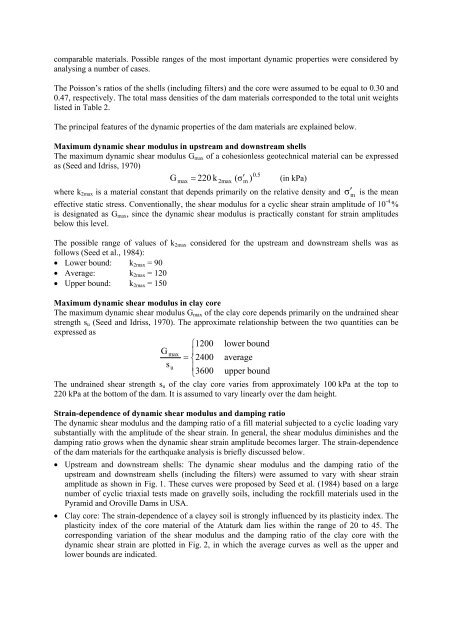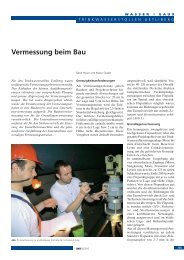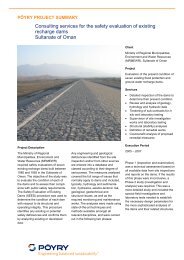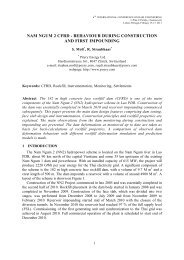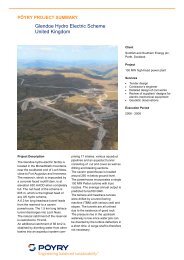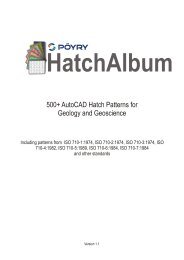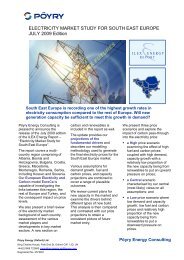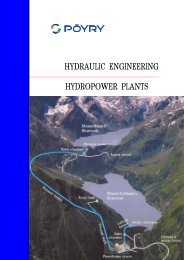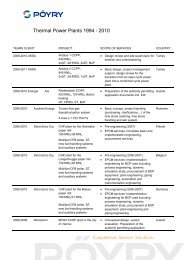EARTHQUAKE SAFETY EVALUATION OF ATATURK DAM
EARTHQUAKE SAFETY EVALUATION OF ATATURK DAM
EARTHQUAKE SAFETY EVALUATION OF ATATURK DAM
You also want an ePaper? Increase the reach of your titles
YUMPU automatically turns print PDFs into web optimized ePapers that Google loves.
comparable materials. Possible ranges of the most important dynamic properties were considered by<br />
analysing a number of cases.<br />
The Poisson’s ratios of the shells (including filters) and the core were assumed to be equal to 0.30 and<br />
0.47, respectively. The total mass densities of the dam materials corresponded to the total unit weights<br />
listed in Table 2.<br />
The principal features of the dynamic properties of the dam materials are explained below.<br />
Maximum dynamic shear modulus in upstream and downstream shells<br />
The maximum dynamic shear modulus Gmax of a cohesionless geotechnical material can be expressed<br />
as (Seed and Idriss, 1970)<br />
0.<br />
5<br />
G max = 220 k 2max ( σ′<br />
m ) (in kPa)<br />
where k2max is a material constant that depends primarily on the relative density and σ′ m is the mean<br />
effective static stress. Conventionally, the shear modulus for a cyclic shear strain amplitude of 10 -4 %<br />
is designated as Gmax, since the dynamic shear modulus is practically constant for strain amplitudes<br />
below this level.<br />
The possible range of values of k2max considered for the upstream and downstream shells was as<br />
follows (Seed et al., 1984):<br />
• Lower bound: k2max = 90<br />
• Average: k2max = 120<br />
• Upper bound: k2max = 150<br />
Maximum dynamic shear modulus in clay core<br />
The maximum dynamic shear modulus Gmax of the clay core depends primarily on the undrained shear<br />
strength su (Seed and Idriss, 1970). The approximate relationship between the two quantities can be<br />
expressed as<br />
⎧1200<br />
lower bound<br />
G max ⎪<br />
= ⎨2400<br />
average<br />
s u ⎪<br />
⎩3600<br />
upper bound<br />
The undrained shear strength su of the clay core varies from approximately 100 kPa at the top to<br />
220 kPa at the bottom of the dam. It is assumed to vary linearly over the dam height.<br />
Strain-dependence of dynamic shear modulus and damping ratio<br />
The dynamic shear modulus and the damping ratio of a fill material subjected to a cyclic loading vary<br />
substantially with the amplitude of the shear strain. In general, the shear modulus diminishes and the<br />
damping ratio grows when the dynamic shear strain amplitude becomes larger. The strain-dependence<br />
of the dam materials for the earthquake analysis is briefly discussed below.<br />
• Upstream and downstream shells: The dynamic shear modulus and the damping ratio of the<br />
upstream and downstream shells (including the filters) were assumed to vary with shear strain<br />
amplitude as shown in Fig. 1. These curves were proposed by Seed et al. (1984) based on a large<br />
number of cyclic triaxial tests made on gravelly soils, including the rockfill materials used in the<br />
Pyramid and Oroville Dams in USA.<br />
• Clay core: The strain-dependence of a clayey soil is strongly influenced by its plasticity index. The<br />
plasticity index of the core material of the Ataturk dam lies within the range of 20 to 45. The<br />
corresponding variation of the shear modulus and the damping ratio of the clay core with the<br />
dynamic shear strain are plotted in Fig. 2, in which the average curves as well as the upper and<br />
lower bounds are indicated.


